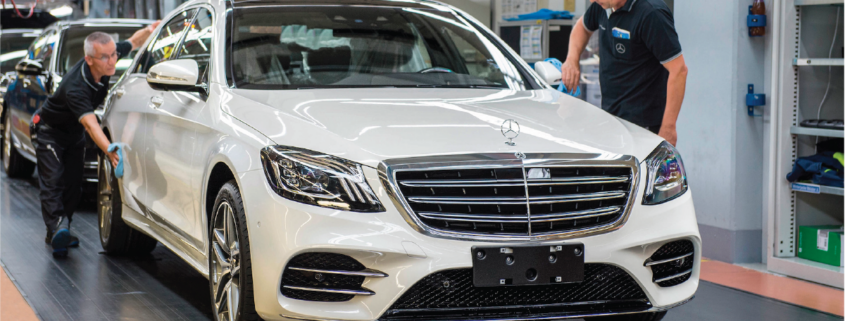Enterprises don’t need to fear disrupters,
but the disruption in the capital market
A growing number of enterprises feel the headwind from capital markets. Up and coming businesses get valuations far above conventional businesses that may be more than ten times as big. Those warning signals all too often are simply ignored. But that could become a fatal mistake.
Innovation takes 7 to 10 years
![]() Theoretically, enough time for any established market player to respond and fight back. But it isn’t quite that easy. If you look at the early years of the then, new automaker, Tesla, you notice that the established players sold more cars in some metropolitan cities in a month than Tesla sold globally in an entire year. Airbnb sold so few vacation rentals a year that established hotel chains didn’t even notice. Early freelancer platforms connect some inexpensive workers with businesses who had a short-term need in a way that the established recruiting firms didn’t even take the time to understand their business. Now, some people may say this is ignorance. But taking the sheer number of companies and enterprises that have tried something and failed into consideration, an enterprise cannot respond to any brain spark that may happen in this world. However, one group does take that time and effort for a very different reason.
Theoretically, enough time for any established market player to respond and fight back. But it isn’t quite that easy. If you look at the early years of the then, new automaker, Tesla, you notice that the established players sold more cars in some metropolitan cities in a month than Tesla sold globally in an entire year. Airbnb sold so few vacation rentals a year that established hotel chains didn’t even notice. Early freelancer platforms connect some inexpensive workers with businesses who had a short-term need in a way that the established recruiting firms didn’t even take the time to understand their business. Now, some people may say this is ignorance. But taking the sheer number of companies and enterprises that have tried something and failed into consideration, an enterprise cannot respond to any brain spark that may happen in this world. However, one group does take that time and effort for a very different reason.
Financial Market Analysts get Extremely Smart
![]()
In the past years, top investment firms completely disrupted the financial market. Yet it went almost unnoticed. With far more detailed insights, more intelligent tools, and evolving algorithms, they are able to predict the success probabilities of new market entrants/enterprises to a degree that was unimaginable just a few years ago. CEOs, Board Members, Unions, Investor representatives, and enterprises as a whole will need to shift gear when it comes to innovation. Future-oriented investment decisions drive market caps (value of a company) into new directions. It’s no longer only in the tech space but now also in all other industries like the auto industry, the tourist and hospitality industry, in the business services where a substantial shift is happening: The capital market favors innovation over profitability and size. One newcomer in that market is investment management company ARK-Invest who states on their website “We Invest Solely In Disruptive Innovation”. And the reason is obvious; in the next 10 years, it is more likely that those new and innovative businesses will win, than the established and slowly evolving companies.
Innovation is Entering all Industries
![]() We randomly choose Hospitality, Automotive, and Business Services in our research. You can see how companies with rapid growth into a large industry segment, while there is no or no adequate response from the current market leaders are seen by the capital market today.
We randomly choose Hospitality, Automotive, and Business Services in our research. You can see how companies with rapid growth into a large industry segment, while there is no or no adequate response from the current market leaders are seen by the capital market today.
AIRBNB
2007 first 3 guests – the company was founded
2009 21,000 guests
2018 300 Million guests
2021 market cap $93 Billion *
2021 Hilton market cap $36 Billion *
TESLA
2012 2,000 or so cars
2015 35,000 cars
2020 1,000,000 cars
2021 market cap $570 Billion *
2021 Daimler market cap $84 Billion *
FIVERR
2010 Some 1,000 jobs at $5 each
2012 estimated $6 Million
2018 estimated $100 Million in revenue
2021 market cap $7 Billion *
2021 Kern Ferry market cap $3.1 Billion *
at $2 Billion in revenue
* = June 15, 2021
Is the world insane? Then, what was with the market caps of Intel, Cisco, Microsoft, Google Facebook, and so forth. What happened to their competitors like DEC, Amdahl, Zilog, Alta Vista, AOL, or MySpace? Today the disrupters are identified much earlier and get evaluated much earlier to higher levels. Not to help them and not to kill others. The new behavior is only a logical consequence of the desire to be in a rising giant early. The advantage for established enterprises: They get a brand new early warning system. But even then, there is a potential for huge mistakes as you can see in our mini case study below.
Innovate or Get Disrupted
![]() Trying to counter-attack a market intruder that has a disruptive business model or disruptive product, by trying to build something better is not leading to any success. A weak attempt to focus on “Gradual Innovation”, which is nothing but improvement, is definitely not an adequate response either. The only way to counter an innovation from a competitor, no matter what size or age, is by another groundbreaking innovation. Improvement is important – but it isn’t withstanding an innovation. Trying to be better than the new innovator is only an improvement and makes the former leader a follower of the new innovator.
Trying to counter-attack a market intruder that has a disruptive business model or disruptive product, by trying to build something better is not leading to any success. A weak attempt to focus on “Gradual Innovation”, which is nothing but improvement, is definitely not an adequate response either. The only way to counter an innovation from a competitor, no matter what size or age, is by another groundbreaking innovation. Improvement is important – but it isn’t withstanding an innovation. Trying to be better than the new innovator is only an improvement and makes the former leader a follower of the new innovator.
MERCEDES BENZ CASE STUDY
The Daimler AG was an investor in Tesla. But eventually lost interest and sold the shares. Tesla was built on 5 unique aspects: 1) A very fast electric motor 2) New high capacity batteries 3) A big display giving space to all kinds of information 4) A digital experience that went far beyond the proprietary “Board Computer” and 5) A customer experience not seen from the conventional carmakers.
The competition only saw the electric motor and battery. They also did not see the timeline that it took 5 years from introducing the first Tesla to getting it at least a bit off the ground. Chevrolet killed its EV short after launch because they thought the market does not exist. Mercedes ignored it completely, then began to invest and built the EQ series. But it was only the replacement of the motor and tank for an electric motor and batteries.
Only with the EQS, Mercedes finally pushed the innovation button in many ways – BUT – chose not to really talk about it. Still, a market leader by the volume of cars they produce, Mercedes became a follower and did not push their innovation but what Tesla has since 10 years: Motor, Battery, and a “hyper display”. The digital experience and also the customer experience fell behind. And the innovation they made was not even mentioned. When the tough gets going the going gets tough.
Instead of standing their ground and continuing rejecting a large display in or on the dashboard and introducing their innovative head-up display – they competed in a space that has no future for both cars. Instead of drumming up their real innovation, they ignored it because they did not understand what customers want. The innovative MBUX system with a large display mirrored on the windshield, supported by a perfect and unique augmented reality system was not part of the competition. The leader turned into a follower and the capital market recognized it. How is this possible?
Things you can do to correct the current direction
![]() Innovation is everything but a small club of thinking and researching innovators playing in their innovation labs.
Innovation is everything but a small club of thinking and researching innovators playing in their innovation labs.
1) It needs an innovation mandate from the CEO.
2) It needs a robust innovation strategy that is blessed by the board
3) It requires innovation managers with exceptional talents and abilities – not skills.
4) An innovation process that empowers the team to develop brilliant ideas and then conducts relentless execution.
THE FIRST STEP however is an innovation readiness assessment that makes sure enterprises have the foundation for what is coming.
BlueCallom offers free Innovation Readiness Checks with no obligation at all.
WHY DO WE CARE EVEN BEYOND OUR OWN BUSINESS
Part of that first step is the understanding that by 2050 we will want to change our energy supply, the energy grid, or whatever we can create, we need renewable energies and tap into energy sources we don’t even think of today. We will want to create transport infrastructure for people, goods, and service infrastructure that is far beyond our today’s abilities. We need to have digitized commerce, business transactions, return services, and handling that is far more intelligent than today. We want to make sure that our health systems, health understanding, and sources for health failure are much better structured, organized, affordable, and available. While we could theoretically feed all people on earth even with a 20 billion population it works only if we can integrate those 20 billion people as contributors to our global society, economy, and humanity. Today only a handful of people seriously try to engage in terraforming mars or build a lunar station. That is far too less to be effective and far too less to prevent new monopolies.



 Focused on the product side. This is the classic way to innovate and the most obvious to be recognized by the market. However, it is also the easiest to copy and to outperform quickly. Product innovation offers room for different degrees of innovation like a profound improvement of a product that changes the way users work or introduces a radically different product that may change a whole industry segment. Competing with product innovation is oftentimes done by starting a price war, and very quickly, the innovator may be forced to reduce pricing, increase marketing effort, or take a much longer time to grow market share. Alternative products as such innovation can quickly substitute product innovation is the most obvious, the most visible, and the fastest to understand. In the past 20 years, business model innovation, experience innovation, or organizational innovation continuously won over product innovation. Probably one of the best examples is the automobile industry. Companies fight on the product level: electric motor or combustion engine. One company, Tesla, does not lead on the product level but uses one of the hardest nuts to crack, multi-facet innovation. On the surface, it is, of course, the electric car. But when looking under the hood, not literally speaking, it is the business model innovation, the organizational innovation, and the experience innovation that makes the company the market leader despite having a much smaller production volume. While the global awareness for Tesla was achieved with its super fast and wide-ranging electric car plus its early engagement in autonomous driving, the whole wide-angle view of the Tesla management, including building the charging stations and the gigantic innovation on the battery side, came from an organizational innovation thinking, the way the cars can be configured and ordered and how easy it is to understand what a user gets is part of the experience innovation, the whole pricing pressure, initial losses and ways the cars get sold is part of the business model innovation. No other car manufacture in the world was so innovative on all fronts and took the automobile no longer as a single product – but a part of holistic user experience. Another example is Microsoft. It’s no news that Microsoft never invented a single product. The operating systems, DOS, and Windows have been acquired, and so were all the office products, the SQL server, and other tools acquired. So one could say Microsft is the least innovative tech company in the world. All they did is integrated all the products and sold them under their own brand. Many are still not fully integrated – 30 years later. Instead of putting all the resources, time, and money into building the solution, they needed to fulfill the vision they acquired. Microsoft’s real innovation is to create a user experience through integration and seamless exchange of data that nobody else saw as important. Nobody else did as well as they did. The experience innovation did not need a product but an architecture. The other innovation was a business model innovation. From the very early days, they committed not to build their own computers but pushed computer manufacturers to use their software. The non-compete commitment from Microsoft was compelling enough to get an exclusive commitment from the computer vendors. And knowing that all the office apps will need their operating system was good enough to give the OS away for peanuts. Business model innovation and experience innovation were strong. Understanding how the company operates and what they offer was so confusing for most competitors that nobody cracked their dominance – till today. As we will discuss other innovation types in the following posts, you will see the difference of those innovation types relative to the ‘good old’ product innovation. You will see that product innovation is not going away – it’s still an important part of an innovative business. Product innovation is becoming a commodity – but is no longer a differentiator.
Focused on the product side. This is the classic way to innovate and the most obvious to be recognized by the market. However, it is also the easiest to copy and to outperform quickly. Product innovation offers room for different degrees of innovation like a profound improvement of a product that changes the way users work or introduces a radically different product that may change a whole industry segment. Competing with product innovation is oftentimes done by starting a price war, and very quickly, the innovator may be forced to reduce pricing, increase marketing effort, or take a much longer time to grow market share. Alternative products as such innovation can quickly substitute product innovation is the most obvious, the most visible, and the fastest to understand. In the past 20 years, business model innovation, experience innovation, or organizational innovation continuously won over product innovation. Probably one of the best examples is the automobile industry. Companies fight on the product level: electric motor or combustion engine. One company, Tesla, does not lead on the product level but uses one of the hardest nuts to crack, multi-facet innovation. On the surface, it is, of course, the electric car. But when looking under the hood, not literally speaking, it is the business model innovation, the organizational innovation, and the experience innovation that makes the company the market leader despite having a much smaller production volume. While the global awareness for Tesla was achieved with its super fast and wide-ranging electric car plus its early engagement in autonomous driving, the whole wide-angle view of the Tesla management, including building the charging stations and the gigantic innovation on the battery side, came from an organizational innovation thinking, the way the cars can be configured and ordered and how easy it is to understand what a user gets is part of the experience innovation, the whole pricing pressure, initial losses and ways the cars get sold is part of the business model innovation. No other car manufacture in the world was so innovative on all fronts and took the automobile no longer as a single product – but a part of holistic user experience. Another example is Microsoft. It’s no news that Microsoft never invented a single product. The operating systems, DOS, and Windows have been acquired, and so were all the office products, the SQL server, and other tools acquired. So one could say Microsft is the least innovative tech company in the world. All they did is integrated all the products and sold them under their own brand. Many are still not fully integrated – 30 years later. Instead of putting all the resources, time, and money into building the solution, they needed to fulfill the vision they acquired. Microsoft’s real innovation is to create a user experience through integration and seamless exchange of data that nobody else saw as important. Nobody else did as well as they did. The experience innovation did not need a product but an architecture. The other innovation was a business model innovation. From the very early days, they committed not to build their own computers but pushed computer manufacturers to use their software. The non-compete commitment from Microsoft was compelling enough to get an exclusive commitment from the computer vendors. And knowing that all the office apps will need their operating system was good enough to give the OS away for peanuts. Business model innovation and experience innovation were strong. Understanding how the company operates and what they offer was so confusing for most competitors that nobody cracked their dominance – till today. As we will discuss other innovation types in the following posts, you will see the difference of those innovation types relative to the ‘good old’ product innovation. You will see that product innovation is not going away – it’s still an important part of an innovative business. Product innovation is becoming a commodity – but is no longer a differentiator. The most effective way to innovate, only recognized by users and communicated through advocacy. Experiences include general customer experience all the way to entire entertainment solutions such as theme parks or highly interactive restaurant types, and lately, space travel. Experience innovation is very hard to copy and very hard to compete with. Usually, it takes highly creative minds to piggyback on a concept and develop a different model that makes the experience unique.
The most effective way to innovate, only recognized by users and communicated through advocacy. Experiences include general customer experience all the way to entire entertainment solutions such as theme parks or highly interactive restaurant types, and lately, space travel. Experience innovation is very hard to copy and very hard to compete with. Usually, it takes highly creative minds to piggyback on a concept and develop a different model that makes the experience unique. The most successful way to innovate with a big impact on the industry. Typically, business model innovation goes hand in hand with experience innovation. It is the hardest innovation type for any competition to copy, even to compete with. Changing a business model is hard enough for a business to develop – it takes years for the competition to emulate and follow. Business model innovation has been the most successful type of innovation in the past 20 years. The biggest number of business model innovations emerged from the US.
The most successful way to innovate with a big impact on the industry. Typically, business model innovation goes hand in hand with experience innovation. It is the hardest innovation type for any competition to copy, even to compete with. Changing a business model is hard enough for a business to develop – it takes years for the competition to emulate and follow. Business model innovation has been the most successful type of innovation in the past 20 years. The biggest number of business model innovations emerged from the US. Innovation within the organization, mainly for process acceleration, customer experience, resulting in increased profitability. It is tough to copy (if not done by consultants), making it very hard to understand from the outside and even the inside. Organizational innovation often requires a deep injection of new processes, different employees, and often a different management team. In large organizations, hundreds or even thousands of people may be affected by organizational innovation when they cannot unlearn and learn new ways of conducting their work. One question quickly rises to the top: “Is innovation killing jobs or the wrong team killing innovation?”
Innovation within the organization, mainly for process acceleration, customer experience, resulting in increased profitability. It is tough to copy (if not done by consultants), making it very hard to understand from the outside and even the inside. Organizational innovation often requires a deep injection of new processes, different employees, and often a different management team. In large organizations, hundreds or even thousands of people may be affected by organizational innovation when they cannot unlearn and learn new ways of conducting their work. One question quickly rises to the top: “Is innovation killing jobs or the wrong team killing innovation?” Supra-Enterprises, companies bigger than 25,000 employees, seem to have the hardest time creating truly ground-breaking innovation. In particular, in the western world, Top Executives, boards, Investor representatives, Unions, Industry associations, local government representatives, and maybe more have to agree on creating a new leadership structure to bring innovation forward. Inventing disruptive solutions often require major changes in the current teams as skills and experiences may shift significantly. Disruption in the automotive, energy, food industry requires knowledge and deep experiences in those industries not only on the enterprise side but also in external structures. A startup as a small company can go under the radar – a public company cannot.
Supra-Enterprises, companies bigger than 25,000 employees, seem to have the hardest time creating truly ground-breaking innovation. In particular, in the western world, Top Executives, boards, Investor representatives, Unions, Industry associations, local government representatives, and maybe more have to agree on creating a new leadership structure to bring innovation forward. Inventing disruptive solutions often require major changes in the current teams as skills and experiences may shift significantly. Disruption in the automotive, energy, food industry requires knowledge and deep experiences in those industries not only on the enterprise side but also in external structures. A startup as a small company can go under the radar – a public company cannot.
 https://www.motorauthority.com/news/1111403_the-2018-mercedes-benz-s-class-drives-itself-off-the-production-line
https://www.motorauthority.com/news/1111403_the-2018-mercedes-benz-s-class-drives-itself-off-the-production-line